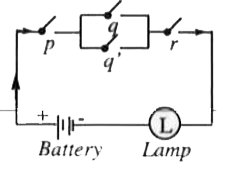A : For a given conductor , electric current does not vary even if its cross sectional area varies .
R : A conductor remains unchanged when current flows through it .
If both Assertion & Reason are true and the reason is the correct explanation of the assertion , then mark
If both Assertion & Reason are true but the reason is not the correct explanation of the assertion then mark.
If Assertion is ture statement but Reason is false , then mark
If both Assertion and Reason are false statements then mark.
The correct Answer is:B
To solve the question, we need to analyze the assertion (A) and the reason (R) provided.
1. Understanding the Assertion (A):
- The assertion states that for a given conductor, the electric current does not vary even if its cross-sectional area varies.
- According to the principle of conservation of charge, the amount of charge entering a section of the conductor must equal the amount of charge leaving that section in a given time interval.
2. Current Definition:
- Current (I) is defined as the rate of flow of charge, mathematically represented as:
I=dQdT
- If we assume a time interval dT=1 second, then the current can be simplified to the total charge flowing through the conductor in that time.
3. Charge Flow in Different Sections:
- Let’s denote the current entering through one terminal (A) as I and the current exiting through another terminal (B) as I′.
- If Q1 is the charge flowing into terminal A in one second and Q2 is the charge flowing out of terminal B in one second, we have:
Q1=IandQ2=I′
4. Applying Conservation of Charge:
- Since the conductor cannot hold charge, the charge entering must equal the charge exiting:
Q1=Q2⇒I=I′
- This shows that the current remains constant regardless of the changes in the cross-sectional area of the conductor.
5. Understanding the Reason (R):
- The reason states that a conductor remains unchanged when current flows through it.
- This is true because as the current flows, the entire charge entering one end of the conductor exits the other end without any accumulation of charge within the conductor itself.
6. Conclusion:
- Since both the assertion and the reason are true, and the reason correctly explains the assertion, we conclude that both are correct.
Final Answer:
- Both Assertion (A) and Reason (R) are true, and R is the correct explanation for A.
- The assertion states that for a given conductor, the electric current does not vary even if its cross-sectional area varies.
- According to the principle of conservation of charge, the amount of charge entering a section of the conductor must equal the amount of charge leaving that section in a given time interval.
- Current (I) is defined as the rate of flow of charge, mathematically represented as:
I=dQdT
- If we assume a time interval dT=1 second, then the current can be simplified to the total charge flowing through the conductor in that time.
- Let’s denote the current entering through one terminal (A) as I and the current exiting through another terminal (B) as I′.
- If Q1 is the charge flowing into terminal A in one second and Q2 is the charge flowing out of terminal B in one second, we have:
Q1=IandQ2=I′
- Since the conductor cannot hold charge, the charge entering must equal the charge exiting:
Q1=Q2⇒I=I′
- This shows that the current remains constant regardless of the changes in the cross-sectional area of the conductor.
- The reason states that a conductor remains unchanged when current flows through it.
- This is true because as the current flows, the entire charge entering one end of the conductor exits the other end without any accumulation of charge within the conductor itself.
- Since both the assertion and the reason are true, and the reason correctly explains the assertion, we conclude that both are correct.
- Both Assertion (A) and Reason (R) are true, and R is the correct explanation for A.
Similar Questions
Knowledge Check
Assertion: The resistance of a conductor decreases with increase in cross sectional area.
Reason: On increasing the cross sectional area of a conductor, more current will flow through the conductor.AIf both assertion and reason are true and reason is the correct explantion of assertion.BIf both assertion and reason are true and reason is not the correct explantion of assertion.CIf assertion is false but reason is true.DIf assertion is true but reason is false.
A charge 0.5C passes through a cross section of a conductor in 5s. Find the current.
View SolutionWhen does the current flow through the following circuit ?

View SolutionThe current density is defined as the current flowing per unit area of cross section of the conductor. Its direction is
View SolutionA conductor-carries a current of 50μA If the area of cross-section of the conductor is 50mm2, then value of the current density in Am−2
View SolutionWhen no current is passed through a conductor,
View SolutionWhen a current passes through a resistor, its temperature increases. Is it an adiabatic process?
View SolutionIf n,e,A and vd are free electron density inside conductor , charge of electron , area of cross-section of conductor and drift velocity of free electrons inside conductor, then current l through the conductor is
View Solution
